All about kirigami
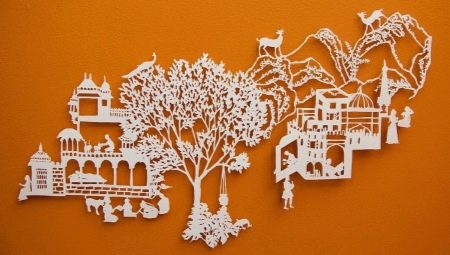
Kirigami is an art form that requires a certain amount of perseverance from the master. Even working according to a special template, it is necessary to strictly follow the proportions and recommendations. You can make something original using ordinary scissors and paper at hand. The paper can be colored or plain, the finished product will not become less impressive from this. Literally the translation of the word kirigami from Japanese means "cut paper". Compared to other types of needlework, this one is relatively recent. It was first mentioned in 1980.


What it is?
Today no one can name the exact date when the art of kirigami appeared, but the peak of its popularity falls on the 80s of the twentieth century. In the common people, this art began to be called paper architecture. In order for the technique to become ideal and, in order to achieve real mastery in the reproduction of various products, a beginner or a master will have to constantly practice.
To begin with, a specific template is selected, after which the details are cut out. You can cut from a single sheet of paper, or from several. To obtain volumetric fragments or a whole figure, you will need to unfold the sheet. In the process of work, you will need to attract a fair amount of imagination and, accordingly, a set of tools. In addition to ordinary scissors, small office knives, different in shape and size, can be suitable for work.

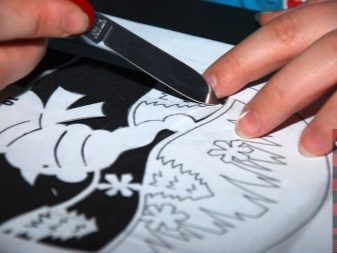
Kirigami can be seen, for example, in popular folding children's books. All this is created by hand, and paper figures recreate scenes from history in an original and visual way. When you turn the pages, you get the feeling of real dynamics of the narrative.And bright colors and careful study only enhance the perception. Postcards where figures can be assembled separately and inserted into specially cut fields also belong to the kirigami industry.
They do not deteriorate with careful handling, and when unfolded they easily form a visual picture.


Origin history
Nowadays, kirigami has become a branch of paper architecture, and it originated in Japan at the end of the last century. Only at the very beginning of the 80s, thousands of different schemes and models were created. It is this art that has become the basis for the production of modern 2D and 3D postcards. Master Masahiro Chatani was able to immortalize his name in history, creating a fundamentally new direction in needlework. Two-dimensional and three-dimensional architectural models of different colors, congratulatory gifts and reproduction of production models from paper were made possible by the advent of kirigami. In this case, various materials and tools are used.
- Cardboard or thin enough colored papernot exceeding a density of 120 grams per square meter. This kind of paper is easy to find in the office. As for the required dimensions, this is specified depending on the chosen scheme. The paper sheet is folded in half after transferring a diagram or drawing to it.
- Small craft scissors. These can be purchased at a specialty store. Sharp tips and a thin blade are the main prerequisite, and those that are usually used when embroidering will do.


Depending on the complexity of the chosen idea, the technique of work also changes. For example, with a solid pattern, the paper will need to be pierced a little. To avoid "misfires" and sharp edges, the tips of the scissors are not brought to the end during work, and the workpiece itself is constantly turning. Sometimes the list of required tools, depending on the scheme, may include:
- stationery knives of various shapes and sizes;
- a special handicraft knife for working with small fragments;
- rubber mat for fixing the craft during work;
- paper clips (sold with rugs);
- special spatula for smoothing paper;
- a metal ruler and a simple pencil to indicate the markup;
- durable adhesive pencil that does not leave marks after drying.



Species overview
The kirigami has several directions, as in any branch of art.
- Jenigami, which is based on the use of three-dimensional shapes. They are prepared separately and stored folded. No glue is required to create.



- Origami - products from several paper sheets. The technique is based on the fact that the paper is folded in a unique way, forming the desired shape.
In this case, you do not need to cut or align small parts.


- Kusudam - a direction derived from origami, more complex. It is thanks to this technique that paper bouquets or compositions are subsequently collected. In complex products, special threads or glue are sometimes used.


- Scrapbooking - the art of making albums or diaries out of paper. Even old magazines or newspaper clippings can serve as a basis.
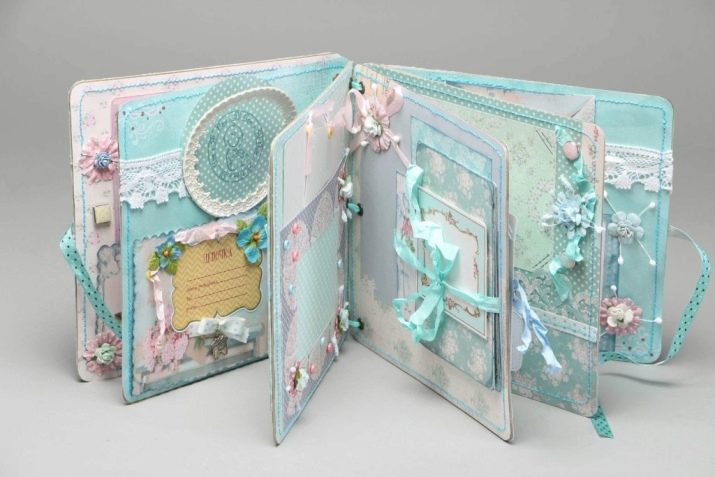
There are a number of prompts to follow when choosing a specific template or pattern to reproduce. For example, the solid lines in the diagram show the direction of the cut. The dotted line is the bend of the product lines inward, and a few dashed dots are the direction of the bend outward. When making, the master will need patience and perseverance. Do not be upset if something does not work out the first time, the most important advice is to act "from simple to complex."


Flat
Flat kirigami is a separate art form, the main part of the work in which is the preparation of the image itself. It usually abounds in many small details and intricate patterns. For reproduction, a monochromatic background and bright, contrasting colors are used. The most striking example is the manufacture of traditional flat New Year's paper snowflakes.In many cities, this is as indispensable a decoration on the windows as bright garlands.


Volumetric
Bulky crafts will require much more care, experience and work. Reproducing three-dimensional designs is not a task for a beginner, but if you follow the instructions, nothing is impossible in this. You can recreate anything from a house to a castle or the most real historical or art scenes. The 3D image is folded thanks to cuts, folds and holes. The more complex the design, the more paper will be required in the process. But the result will really pay off, such a craft can become an interesting idea for a handmade gift for family and friends.


Schemes for beginners
You can understand how to make postcards using the kirigami technique not only by attending a master class. The first thing that is required of the user is to prepare everything necessary for work and choose the appropriate template for manufacturing. As starting materials and tools, paper and scissors are suitable, and sometimes stationery knives for more sophisticated work with small details.


The work algorithm is simple.
For example, to make a Valentine's card step by step for the holiday, the sequence of operations will be as follows.
- Calculate or redraw the template. The heart can be located on A4 or A5 sheet, the main thing is that the paper is thick enough.
- According to the scheme, without getting out of the edges, you can start cutting the paper with a clerical knife or scissors. It all depends on the individual preferences of the user. The main thing is that in the end there are no uneven or dangling edges.
- Cut small parts separately, fold the paper sheet.
- Inside, you can write both wishes and the name of the recipient. If you don't want to color the postcard, you can immediately use colored paper or cardboard as a starting material.
- Stretch the spiral of the heart and fold the figure, attach the middle part to one of the halves of the heart, for the sake of volume, you can bend the figure outward and get a three-dimensional valentine.





Thanks to the template, you can easily create a castle or a house out of paper. But scissors and other tools will need thinner ones to reproduce true paper architecture. For some things, you can even use a scalpel. Do not forget about the safety rules. For a castle or house you will need:
- carefully draw the contours and details for the workpiece;
- trim all contours, starting from the top and ending with the bottom;
- horizontal lines remain intact so that later you can easily fold the figure;
- towers and contours are cut gradually, the work always goes from top to bottom;
- openings and other holes at the bottom are cut along the contour;
- windows are cut out separately;
- the bend of the workpiece goes from above and from the middle of the structure.

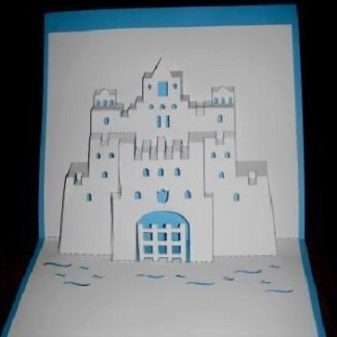
Even glue can be used in more complex designs. Sometimes it makes sense to prepare the background for the castle separately, so that the volume and detail of the figure look more impressive. It is better to choose a background color. It can be a panoramic drawing with a sunset, a steppe, or a real forest under the towers. Depending on the complexity, the speed of work also changes, so you need to be as careful as possible in the process.

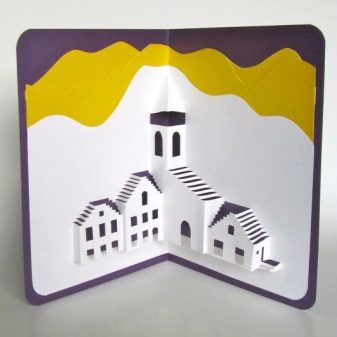
In order to freely create volumetric figures, it is recommended not to forget to use a special rubber backing.
So there is much less risk of spoiling expensive furniture during work. When creating a hut or a house using kirigami, you need to follow a few simple rules.
- You need to cut the paper from the top point, paying attention to all the internal details, dropping to the bottom edges at the very end.
- When working on a tile or roof, you will need to use a thinner blade to reproduce all the details.
- When carving wood, different types of blades can be used. This makes it possible to work with parts at an angle.Before this, the line is cut with a knife, and only then the tip of the scissors themselves is introduced. As you cut, the blades never fully join;
- The folds should be started only after all other parts have been cut. You need to bend the lines from the middle of the craft. A spatula or trowel will help reproduce the curvature of the shingles.


Another scheme for a novice master who strives to master the art of kirigami is a ladder. Here, the user will learn how to wield several tools at once, including shovels, spatulas and a metal ruler. Instead of scissors, some people find it more convenient to use a clerical knife. Any scheme of stairs can be redrawn, but the most difficult thing is to reproduce mirrored steps. The algorithm of actions is as follows:
- lines are cut vertically with a knife;
- then, using a spatula and a spatula, bend the paper, reproducing the inner and outer folds - all this will require care and caution in the process of execution.


The frog is a classic figure for the beginner. It is ideal for children who are just starting to master paper skills. The procedure is quite simple. In the process, you will need to use a high-quality glue stick, which dries quickly and does not leave marks:
- fold a sheet of paper in half, the front side should be inside;
- you can draw a template both in advance and immediately after that;
- carefully cut the frog along the contour on both halves;
- with a short movement, make a small incision for the future mouth and bend the corners of the paper;
- unfold the frog, bend the edges and glue the edges with pencil glue.

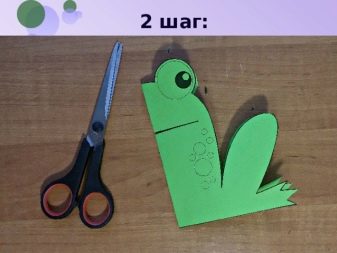



To give the figure volume, it is enough to turn out the corners of the paper on the left and right sides.
The eyes are either drawn or pasted separately. The tongue is cut from another sheet of paper, most often red or pink is preferred. One end must be rounded off; this can be done with glue. The width is selected so that it matches the proportions of the figure. The tongue is glued to the inside of the mouth separately. If a water lily or background is planned for the frog, then the base can be prepared by bending the paper in the right direction. It can be blue or blue-green.


A snowflake for children on New Year's Eve is simply cut along the contour with fairly thin scissors. Most often, for a home or office, the basis of a snowflake is a regular A4 album sheet. The pattern and complexity of the snowflakes can be any, at the discretion of the user. But everywhere it is better to be guided by the principle "from simple to complex", this will make it possible to avoid mistakes, and to develop skills for hands on simpler structures. Then the reproduction of complex products will not present any problems.

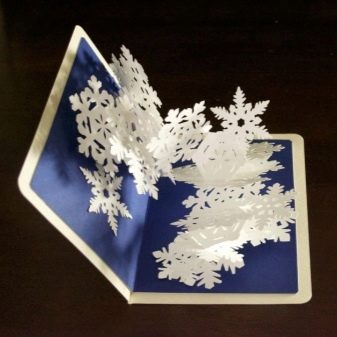
For example, cake for a winter birthday, can be made of paper in the form of a postcard... One of the main steps is to outline clear contours for reproducing the workpiece. 3D construction - correctly folded paper. The folds can be marked not only with a dotted line, but also with color, starting from the middle. For example, blue will be the folds inward, and red will be the outside. Empty fields and the background around is left for the wishes of the recipient of the postcard. If the cake is winter, then a deer may be depicted there. Santa's reindeer and sleigh, for a winter theme, can also be cut separately.

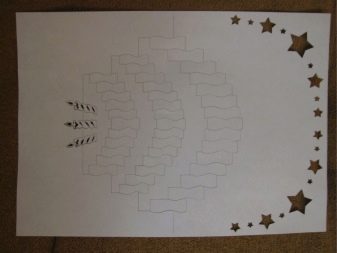


When cutting out a fish, you need to take into account that the paper is divided into two main parts: background and the drawing of the fish itself. It is better to choose colors that are contrasting and not too "hitting" on the eyesight. Double-sided paper is best so that you don't have to glue the craft. All solid lines must be carefully cut, but if the fish has stripes, then they can be left. The paper is folded from the middle, and glued at the corners so that the figure does not fall apart.


To make a snowflake, you need to fold a square out of paper; sharp corners must be combined with each other.As a result, you should get a small triangle or rectangle, which must be carefully cut out without breaking the shape. Then the figure is folded again, all sharp corners should clearly coincide with each other.
The base is leveled and smoothed, and then the snowflake itself is cut along the contour with small scissors.
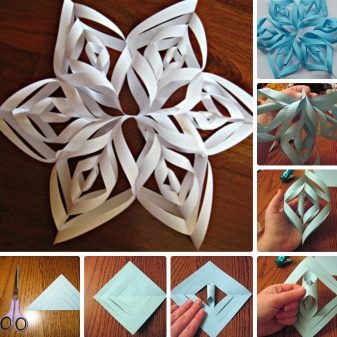

The Christmas tree is another symbol and invariable attribute of New Year's decoration. Why buy a postcard when you can make it by hand? You don't even have to paint the finished product, just use paper or cardboard of different colors and shades. A4 cardboard is best suited for this purpose, Christmas tree decorations can be either drawn or glued. Rhinestones are suitable for a garland.
The inner figure of the Christmas tree is cut with a knife strictly along the lines. Then comes the turn of the contour itself along the edges. Folds are best indicated with a dotted line. The outer fold serves as the basis for the spruce, and the inner fold reproduces it itself. The whole point of the design is a neat fold and carefully traced and cut details.
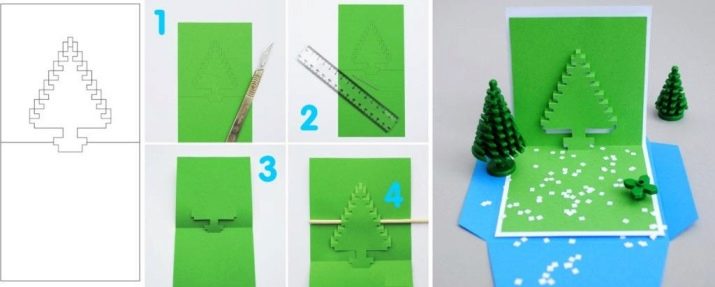
A traditional star or a swan for Victory Day is also not very difficult, you just need to follow the chosen scheme. We use a clerical knife for small parts, and sharp scissors for carving along the contour. It is the fragments and patterns that are cut first and always from the center of the product. You should go to the edges at the very end of the work. A rubber backing and a vice for paper will make it possible to work with the workpiece for a long time, and reduce the risk of spoiling it by careless movement. It makes sense to purchase special knives for kirigami if the user has a desire to master this art professionally.


For information on how to make a voluminous kirigami postcard with your own hands, see the next video.








